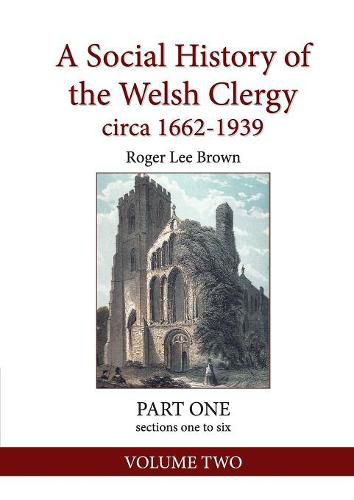Readings Newsletter
Become a Readings Member to make your shopping experience even easier.
Sign in or sign up for free!
You’re not far away from qualifying for FREE standard shipping within Australia
You’ve qualified for FREE standard shipping within Australia
The cart is loading…






This title is printed to order. This book may have been self-published. If so, we cannot guarantee the quality of the content. In the main most books will have gone through the editing process however some may not. We therefore suggest that you be aware of this before ordering this book. If in doubt check either the author or publisher’s details as we are unable to accept any returns unless they are faulty. Please contact us if you have any questions.
Part Two of A SOCIAL HISTORY OF THE WELSH CLERGY contains two sections, on Patronage and on the Income of the Clergy. The study relates to the four Welsh dioceses of the Church of England then in the Province of Canterbury. Patronage, or the right of appointing to a living, was often a source of great grievance for the clergy who desired a living of their own or a better living. Patronage was held by bishops, colleges, the Crown and the Lord Chancellor, as well as by numerous lay persons. This right was frequently abused. English-speaking clergy were appointed to Welsh-speaking parishes, though legislation later enabled bishops to refuse such appointments; nepotism prevailed, especially in the case of bishops and their relations; while livings could be sold or the next presentation sold, for which a sordid but lucrative market existed. Numerous case studies indicate the difficulties of those men, who lacking influence, endeavoured to obtain a parish of their own, and a significant minority never did so. The second section discusses the income of the beneficed clergy. Some parishes were wealthy, others pathetically poor, leading to a plurality of neighbouring parishes. Outgoings against income could be substantial. Many parishes had glebe land, farmed by the incumbent or let out, and some parishes benefited considerably by the enclosure movement increasing this glebe land. The income from the tithe varied considerably, was often subject to dispute, and was governed by local arrangements before it was commuted to a money payment. The fall in tithe income due to the agricultural depression of the 1870s, leading to further disputes and even the riots is fully documented. The augmentations made by Queen Anne’s Bounty are fully noted, while the grants of the Ecclesiastical Commission to populous parishes in augmenting the stipend and the many difficulties of obtaining this assistance, receive chapters of their own, as do the other sources of finance, such as diocesan initiatives.
$9.00 standard shipping within Australia
FREE standard shipping within Australia for orders over $100.00
Express & International shipping calculated at checkout
This title is printed to order. This book may have been self-published. If so, we cannot guarantee the quality of the content. In the main most books will have gone through the editing process however some may not. We therefore suggest that you be aware of this before ordering this book. If in doubt check either the author or publisher’s details as we are unable to accept any returns unless they are faulty. Please contact us if you have any questions.
Part Two of A SOCIAL HISTORY OF THE WELSH CLERGY contains two sections, on Patronage and on the Income of the Clergy. The study relates to the four Welsh dioceses of the Church of England then in the Province of Canterbury. Patronage, or the right of appointing to a living, was often a source of great grievance for the clergy who desired a living of their own or a better living. Patronage was held by bishops, colleges, the Crown and the Lord Chancellor, as well as by numerous lay persons. This right was frequently abused. English-speaking clergy were appointed to Welsh-speaking parishes, though legislation later enabled bishops to refuse such appointments; nepotism prevailed, especially in the case of bishops and their relations; while livings could be sold or the next presentation sold, for which a sordid but lucrative market existed. Numerous case studies indicate the difficulties of those men, who lacking influence, endeavoured to obtain a parish of their own, and a significant minority never did so. The second section discusses the income of the beneficed clergy. Some parishes were wealthy, others pathetically poor, leading to a plurality of neighbouring parishes. Outgoings against income could be substantial. Many parishes had glebe land, farmed by the incumbent or let out, and some parishes benefited considerably by the enclosure movement increasing this glebe land. The income from the tithe varied considerably, was often subject to dispute, and was governed by local arrangements before it was commuted to a money payment. The fall in tithe income due to the agricultural depression of the 1870s, leading to further disputes and even the riots is fully documented. The augmentations made by Queen Anne’s Bounty are fully noted, while the grants of the Ecclesiastical Commission to populous parishes in augmenting the stipend and the many difficulties of obtaining this assistance, receive chapters of their own, as do the other sources of finance, such as diocesan initiatives.